Speed Demon
Air race-inspired aerobat flies like a fighter
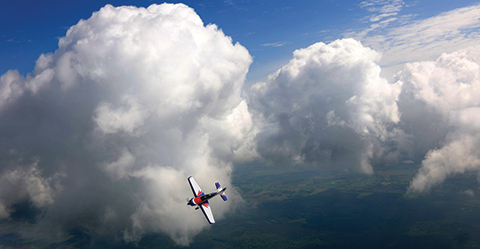
When Walter Extra designed the sleek aerobatic aircraft that bear his name, he knew that they were destined to become mainstays at international competitions and airshows around the world.
What Extra didn’t anticipate, however, is that most of the ever more powerful, nimble, and swift airplanes made for the rigors of aerobatic competition would never be used for their intended purpose. Instead, owners fill them with an array of digital, IFR-capable avionics, including autopilots; fly recreationally; and seldom—if ever—enter aerobatic contests or perform at airshows.
Now, after years of seeing owners, particularly U.S. owners, load their airplanes with high-end avionics and make long cross-country flights, Extra has designed a new aircraft, the Extra 330 LT, to match the way most pilots actually fly his airplanes.
 “We optimized the LT for cross-country flying and preserved its aerobatic capabilities,” said Extra, 56, a mechanical engineer who started building his own single-seat aerobatic airplanes 30 years ago to replace the biplanes that were then starting to become outmoded. “The LT has far more speed and range than the airplanes we build for competition.”
“We optimized the LT for cross-country flying and preserved its aerobatic capabilities,” said Extra, 56, a mechanical engineer who started building his own single-seat aerobatic airplanes 30 years ago to replace the biplanes that were then starting to become outmoded. “The LT has far more speed and range than the airplanes we build for competition.”
Free from the confines of a 1,000-meter-square aerobatic box, the LT (L is for “low wing” and the T is for “tourer”) is the fastest FAA-certified, normally aspirated piston aircraft in existence—and one of the strongest. It has a top straight-and-level speed of 205 knots and it’s rated for plus or minus 10 Gs. It’s powered by a 315-horsepower Lycoming AEIO-580, carries 58 gallons of fuel (in two wing tanks and a fuselage tank), and can fly 580 nm with VFR reserves at 190 knots. (The cruise speed is 18 knots faster than an Extra 300 with symmetrical wings.)
The LT is strongly influenced by lessons Extra learned designing an airplane for the Red Bull pylon air race series. Extra’s race airplane didn’t have the fastest flat-out speed, but its uncanny ability to maintain energy throughout a series of impossibly tight, high-G turns and crushing aerobatic maneuvers allowed it to dominate the field. “The LT has the same airfoil as our Red Bull race plane,” Extra said. “But we modified the wing shape and planform.”
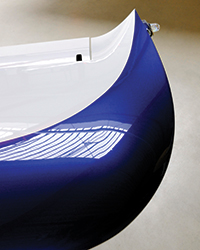 The LT wings have a slight sweep in the leading edges, and the rounded wing tips swirl upward. Unlike some top competition aerobatic airplanes with blindingly fast roll rates approaching 400 degrees per second, the LT rolls at about 270 degrees per second. And that’s part of the design philosophy, too. “We made the ailerons smoother and less aggressive,” Extra said.
The LT wings have a slight sweep in the leading edges, and the rounded wing tips swirl upward. Unlike some top competition aerobatic airplanes with blindingly fast roll rates approaching 400 degrees per second, the LT rolls at about 270 degrees per second. And that’s part of the design philosophy, too. “We made the ailerons smoother and less aggressive,” Extra said.
The balanced control surfaces return to center when released and have higher breakout forces than other Extras. A higher wing angle of incidence means the LT flies with a tail-high attitude that improves forward visibility and has a flatter deck angle in full-stall landings.
LT development took place during 2009—a disastrous year for the general aviation industry. But Extra says macroeconomic trends have little impact on his market niche, where steady demand allows his company’s 65 workers to build about 36 new airplanes a year at a modern factory in the rolling horse country outside northern Germany’s industrial Ruhr River valley.
“I assumed when I started building my aerobatic airplanes that there would be a very limited market for them and I’d run out of customers very soon,” Extra said in lightly accented English. “But I was wrong. Demand has been very stable over the years, and it continues quite strong despite the economic cycles.” The LT’s list price is $379,000.
Extra test-flies every new airplane that emerges from his factory and signs the first logbook entry. He built his first FAA-certified model—the EA 300—in 1990 and the company is on target to deliver its 500th airplane this year.
Not completely crazy
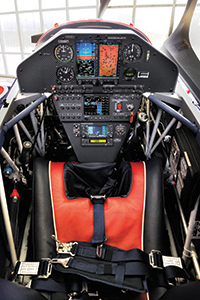 The LT’s two-seat tandem cockpit has a leather interior and a finish as exacting as the Mercedes and BMW luxury cars built nearby. The canopy is made from distortion-free optical glass and can be converted between single- and two-place bubbles. Unlike other Extras, the LT’s baggage compartment (22 pounds capacity) can be opened from outside, and comforts such as cockpit heaters offered as options in his other airplanes are standard in the LT. The LT tail also has curved corners with slightly less span, and a smaller elevator. An electric elevator trim tab is activated by a joystick switch. The LT fuselage is built around the same steel frame as other 300-series Extras and has similar weights and dimensions. But the LT wing isn’t interchangeable with other fuselages and won’t be offered as a retrofit.
The LT’s two-seat tandem cockpit has a leather interior and a finish as exacting as the Mercedes and BMW luxury cars built nearby. The canopy is made from distortion-free optical glass and can be converted between single- and two-place bubbles. Unlike other Extras, the LT’s baggage compartment (22 pounds capacity) can be opened from outside, and comforts such as cockpit heaters offered as options in his other airplanes are standard in the LT. The LT tail also has curved corners with slightly less span, and a smaller elevator. An electric elevator trim tab is activated by a joystick switch. The LT fuselage is built around the same steel frame as other 300-series Extras and has similar weights and dimensions. But the LT wing isn’t interchangeable with other fuselages and won’t be offered as a retrofit.
The LT’s skin is all composite except for a patch of fabric on the lower rear fuselage. The prototype, D-EXLT, has an immaculate, glossy red-white-and-blue paint scheme. The refined, lustrous finish is at odds with the customarily Spartan appearance of most preproduction airplanes, but in keeping with Extra’s perfectionist standards.
Doug Vayda of Southeast Aero, a U.S. sales and service center for Extra Aircraft, guided me through my first flight in the LT at Extra’s manufacturing center in Dinslaken, Germany. He has owned and flown Extras for more than 10 years, and he’s been the U.S. sales representative at the company’s St. Augustine, Florida, headquarters for seven years. A CFI and IA, Vayda knows the German company and its airplanes inside and out, and is a vocal proponent for the LT, helping convert it from an idea to an airplane.
The brash, colorful American traveled to Germany in May to fly the LT for the first time, and suggest changes to make it more appealing to U.S. buyers. His spirited interaction with the company’s German engineers was a study in contrasts and reflected the sometimes broad gulf between the practical, highly regulated European aerobatic purists and the outspoken U.S. pilot and sales executive.
Vayda’s pleas for a top speed in excess of 200 knots and glass avionics had already been met, so he pushed for lesser wish-list items. When he brought up autopilots, an exasperated engineer called them “unnecessary weight.” When Vayda suggested covering the inside of the wing roots to block internal wiring from passenger view, the engineers looked at Vayda blankly. And when he asked that the shock-mounted panels that hold the front-cockpit altimeter and airspeed indicator be made from carbon fiber, they wondered aloud about his sanity.
But at an engineering meeting the very next morning, the engineers determined that the changes Vayda proposed could be accomplished quickly and economically, and all would be incorporated in production aircraft.
The LT is not IFR-certified, and Vayda is prodding Extra engineers to climb that tall regulatory mountain. For now, however, he says he’s pleased with the progress he made in face-to-face talks with Extra’s engineering team. “We usually argue more, and louder,” Vayda said. “But after years of working together, we’ve come to an understanding. I respect them as consummate professionals and the best in the world at what they do, and they realize that I’m not completely crazy.”
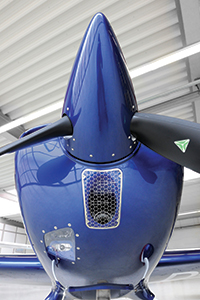 Anticipation to exhilaration
Anticipation to exhilaration
Engine start for the six-cylinder engine is standard, and the Aspen PFD and MFD take about two minutes to initialize. The units have software designed for aerobatics so that they keep up with most maneuvers, and if they lose orientation they can reset themselves in 28 seconds of level flight.
It’s a short taxi from the company’s manufacturing center to the 2,800-foot runway where the wind was gusting to 13 knots at a 45-degree angle across the concrete strip. The LT held about 22 gallons of fuel, and the outside air temperature was 80 degrees Fahrenheit. After a standard engine runup, we were cleared to take off from Runway 9 and my anticipation quickly turned to exhilaration. Initial acceleration is so rapid it makes a person feel in danger of being separated from his soul. But the most surprising aspect of the takeoff roll is the airplane’s modest left-turning tendency. P-factor from the three-blade MT MTV-9 propeller turning 2,700 rpm is counteracted with light, steady pressure on the right rudder pedal.
Holding a tail-low attitude, the airplane lifted off about 65 KIAS after a ground roll of about 500 feet and quickly accelerated through 100 knots in a 10-degree climb. I pitched up to 15 degrees and the airplane held steady at 120 KIAS with the vertical speed indicator pegged at more than 2,000 fpm.
“Go ahead and try the ailerons,” Vayda said, and I banked to 45 degrees left and right in the climb. Breakout forces were light, crisp, and not at all twitchy. The rolls were easy to stop at the intended bank angle, and adverse yaw was minimal and easily corrected with a touch of rudder. “When I say try out the ailerons, I mean try out the ailerons,” Vayda said. “Let’s roll.”
At 25 inches of manifold pressure and 2,500 rpm at 3,000 feet, the airplane was traveling at 180 KIAS. Full-deflection rolls left and right with the nose pitched up five degrees took less than two seconds each. Unlike some Unlimited aerobatic airplanes with roll rates so fast there’s not enough time to apply full ailerons before the roll is complete, the LT allows full deflection and timely rudder inputs.
Slow rolls require some forward pressure and top rudder to keep the nose from falling, but stick and rudder-pedal movements are minute. Loops are easily accomplished from level flight at cruise power, and the initial 3.5-G pull to vertical is accompanied by astonishingly little deceleration. The ASI showed 180 knots at the beginning of a loop and 160 knots at vertical. Usually, the high angle of attack in the initial pull for any over-the-top maneuver induces so much drag that indicated airspeed decreases by one-third, or even more. Not so in the LT.
Airspeed fell to 120 KIAS at zero Gs across to top of the loop, and the LT accelerated rapidly on the way down. Extending the down line at high power will result in the airplane arriving at its 220-knot never-exceed speed in short order.
Stalls are preceded by the chirping stall-warning alarm at about 67 KIAS and light aerodynamic buffeting at 65. The break itself is sharp and slightly left-wing down at 58 KIAS, and recovery takes place the moment back-pressure is relaxed. Unaccelerated spins left and right are conventional, and recoveries are nearly immediate when pro-spin inputs are removed. In fact, there’s simply not enough time to apply full opposite rudder before the rotation stops.
Vayda performed a few tumbling maneuvers, and the LT really shines in this area. It can be difficult, and physically torturous, to get aerobatic airplanes with symmetrical wings to perform outside snap rolls—the starting point for many high-power gyroscopic maneuvers. But the LT’s flat-bottomed airfoil allows it to perform outside snaps without high negative Gs. Full forward stick at about 90 KIAS pushed the LT into a stall at 1.5 negative Gs—a vacation compared to some other aerobatic airplanes that subject pilots to far higher G loads.
In the landing pattern, controlling the LT’s speed and descent rate is a matter of small pitch and power adjustments. There are no flaps, but the propeller provides a great deal of aerodynamic braking as well as instant acceleration.
We targeted 100 KIAS on downwind, 90 on base, and 80 on final. I carried a miniscule amount of power into the flare, then pulled the throttle to idle and brought the stick full aft for a three-point landing. The airplane touched down with the tailwheel first and tracked straight ahead despite the gusty, quartering headwind. No rudder inputs or differential braking were required.
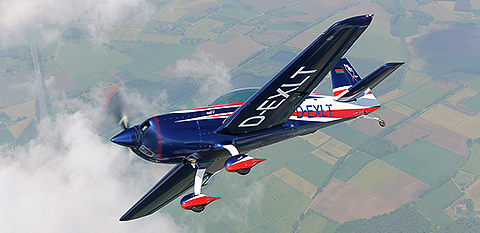
T is for tumble
The LT is a graceful and precise aerobatic performer, and it’s sure to be popular among airshow performers and spectators for whom its higher speeds and dramatic tumbling (the T ought to stand for “tumble” instead of tourer) are big pluses. Its exceptional cross-country capability won’t hurt in this area, either.
The LT is likely to do just fine at aerobatic contests—despite its aerodynamic slipperiness—where it can compete in the IAC Sportsman, Intermediate, and maybe even Advanced categories (although not Unlimited, where compound outside maneuvers are the basis for success). But the LT is going to be most prized by pilots who want their own personal fighters—or Red Bull-style racers—and appreciate the peace of mind that comes from knowing their airplanes are built to world-class manufacturing standards. Outside the confines of an aerobatic box, the LT can fly as strenuously, or as leisurely, as the pilot’s mood and mission dictate.
The LT combines attributes that seem almost self-contradictory: speed and range; agility and strength; refinement and raw power. Those fortunate enough to fly the LT will discover a single airplane that brings these qualities together in abundance.
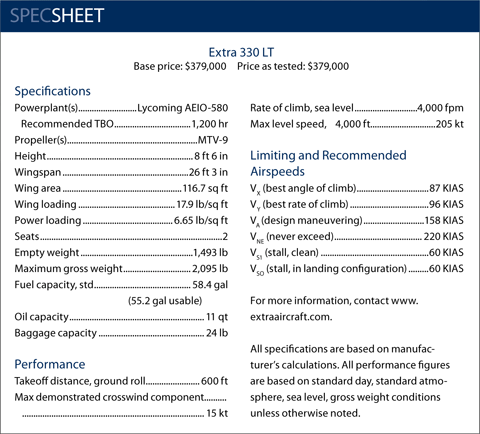
E-mail the author at [email protected].


